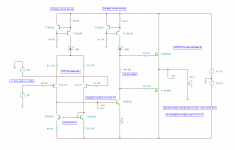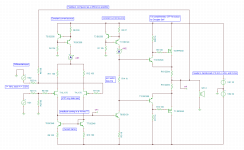Hi all,
This is just a concept that I had dreamed of when I was looking at the Pass ACA class A amplifier schematics.
It uses IRFP240 MOSFET in common-source operation to amplify voltage and current.
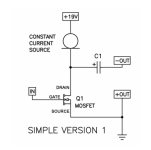
Now, there is a second IRFP240 that is used as constant current source.
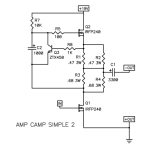
What I was wondering is what if we add a long tailed pair JFETs to be able to accept balanced inputs (XLRs for example)?
I am not experienced that much in transistor circuitry, but I have come up with draft design in TINA-TI simulator. It uses common components and I feel like it is almost complete, but looking for input from other people.
Typical balanced signal is 4Vrms, so I figured the voltage gain should not be that much - 2 or 3 will do. But the current gain is what I am having hard time understanding.
I am thinking worst case scenario is 2 ohm load and with gain of 2 we get 8Vrms so that is 4 Amps. With 4 ohms speaker, it is 2 Amps. Is IRFP240 even capable of such output?
Supply voltage is also not determined...
Attached is simulation file.
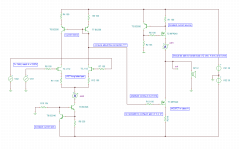
This is just a concept that I had dreamed of when I was looking at the Pass ACA class A amplifier schematics.
It uses IRFP240 MOSFET in common-source operation to amplify voltage and current.

Now, there is a second IRFP240 that is used as constant current source.

What I was wondering is what if we add a long tailed pair JFETs to be able to accept balanced inputs (XLRs for example)?
I am not experienced that much in transistor circuitry, but I have come up with draft design in TINA-TI simulator. It uses common components and I feel like it is almost complete, but looking for input from other people.
Typical balanced signal is 4Vrms, so I figured the voltage gain should not be that much - 2 or 3 will do. But the current gain is what I am having hard time understanding.
I am thinking worst case scenario is 2 ohm load and with gain of 2 we get 8Vrms so that is 4 Amps. With 4 ohms speaker, it is 2 Amps. Is IRFP240 even capable of such output?
Supply voltage is also not determined...
Attached is simulation file.

Attachments
Last edited:
1. You need to define the gain of the LTP, or use global feedback.
2. The DC bias on the active output FET is way off. You need some way to set it to about 4V above the negative rail, ie some way to set the output DC voltage at half the total supply. Again, global feedback would do that, but the LTP needs to be P-channel so that the LTP output is in the right voltage range. Or add another stage that translates the bias down towards the negative rail. Without a capacitor on the output, the DC offset has to be precise, less than 100mV, which ~requires global feedback or a "DC servo".
3. The current mirror is backwards. The output is the other side, not the side with the CB short.
4. +/-30V single ended class-A is only reasonable if you are driving 16 Ohms or higher, ie < 2A. IPRF240 are nice big devices but if you do the thermal math, you need to keep the dissipation < ~60W/device even with a huge heat sink. For 2 Ohm that means about +/-12V max (6A), +/-16V for 4 Ohms (4A). A Push-Pull class A (vs single ended) will give you twice the efficiency, half the idle current.
2. The DC bias on the active output FET is way off. You need some way to set it to about 4V above the negative rail, ie some way to set the output DC voltage at half the total supply. Again, global feedback would do that, but the LTP needs to be P-channel so that the LTP output is in the right voltage range. Or add another stage that translates the bias down towards the negative rail. Without a capacitor on the output, the DC offset has to be precise, less than 100mV, which ~requires global feedback or a "DC servo".
3. The current mirror is backwards. The output is the other side, not the side with the CB short.
4. +/-30V single ended class-A is only reasonable if you are driving 16 Ohms or higher, ie < 2A. IPRF240 are nice big devices but if you do the thermal math, you need to keep the dissipation < ~60W/device even with a huge heat sink. For 2 Ohm that means about +/-12V max (6A), +/-16V for 4 Ohms (4A). A Push-Pull class A (vs single ended) will give you twice the efficiency, half the idle current.
